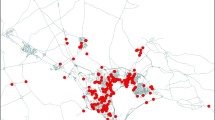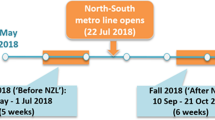Abstract
Taking learning into account when modelling passengers’ route choice behaviour improves understanding and forecasting of their preferences, which helps stakeholders better design public transport systems to meet user needs. Most empirical studies have neglected the relationship between current choices and passengers’ past experiences that lead to a learning process about route attributes. This study addresses this gap by using real observed choices from smart-card data to implement a route choice model that takes into account the learning process of passengers during the inauguration of a new metro line in Santiago, Chile. An instance-based learning (IBL) model is used to represent individually perceived in-vehicle travel time in the route choice model. It accounts for recency and reinforcement of experience using the power law of forgetting. The empirical evaluation uses 8 weeks of smart-card data after the introduction of the metro line. Model parameters are evaluated, and the fit and behavioural coherence achieved by the IBL route choice model is measured against a baseline model. The baseline model neglects passenger learning from experience and assumes that all passengers use only trip descriptive information in their decision-making process. The IBL route choice model outperforms the baseline model from the fourth week after the introduction of the metro line. This empirical evidence supports the notion that after the introduction of a new metro line, passengers initially rely on descriptive travel information to estimate travel times for new alternatives. After a few weeks, they begin to incorporate their own experiences to update their perceptions.



Similar content being viewed by others
Data availability
Not applicable
Code availability
Not applicable
Notes
Some studies have used correlated travel times between route alternatives instead (Tan et al. 2015; Dixit et al. 2023). However, Dixit et al. (2023) found no significant difference in the predictive ability of the distance-based and in-vehicle travel-time-based models for the path-size correction term.
References
Anderson, M.K., Nielsen, O.A., Prato, C.G.: Multimodal route choice models of public transport passengers in the greater copenhagen area. EURO J. Transp. Logist. 6(3), 221–245 (2017)
Arriagada, J.: Formulation of new models of passenger behavior in public transport using fare collection data. PhD thesis, University of Chile (2022)
Arriagada, J., Gschwender, A., Munizaga, M.A., et al.: Modeling bus bunching using massive location and fare collection data. J. Intell. Transp. Syst. 23(4), 332–344 (2019)
Arriagada, J., Munizaga, M.A., Guevara, C.A., et al.: Unveiling route choice strategy heterogeneity from smart card data in a large-scale public transport network. Transp. Res. Part C: Emerging Technol. 134(103), 467 (2022)
Ben-Akiva, M., Bierlaire, M.: Discrete choice methods and their applications to short-term travel decisions. In: Hall, R. (ed.) Handbook of Transportation Science, pp. 5–34. Kluwer, Alphen aan den Rijn (1999)
Ben-Akiva, M., Bierlaire, M.: Discrete choice methods and their applications to short term travel decisions. In: Handbook of Transportation Science, vol. 23, pp 5–33 (1999)
Ben-Elia, E., Shiftan, Y.: Which road do i take? a learning-based model of route-choice behavior with real-time information. Transp. Res. Part A: Policy Pract. 44(4), 249–264 (2010)
Bierlaire, M.: PythonBiogeme: a short introduction. Report TRANSP-OR 160706, Series on Biogeme. Transport and Mobility Laboratory, School of Architecture, Civil and Environmental Engineering, Ecole Polytechnique Fédérale de Lausanne, Switzerland (2016)
Bogers, E.A., Bierlaire, M., Hoogendoorn, S.P.: Modeling learning in route choice. Transp. Res. Rec. 2014(1), 1–8 (2007)
Bovy, P.H., Bekhor, S., Prato, C.G.: The factor of revisited path size: alternative derivation. Transp. Res. Rec. 2076(1), 132–140 (2008)
Cascetta, E., Cantarella, G.E.: A day-to-day and within-day dynamic stochastic assignment model. Transp. Res. Part A: General 25(5), 277–291 (1991)
Chorus, C., Dellaert, B.: Inertia in travel choice: The role of risk aversion and learning. In: 12th International Conference on Travel Behaviour Research, Jaipur, Rajasthan, India, December 13-18, 2009, Citeseer (2009)
Dixit, M., Cats, O., Brands, T., et al.: Perception of overlap in multi-modal urban transit route choice. Transport. A Transp. Sci. 19(2), 2005180 (2023)
Erev, I., Barron, G.: On adaptation, maximization, and reinforcement learning among cognitive strategies. Psychol. Rev. 112(4), 912 (2005)
Fusco, G., Bracci, A., Caligiuri, T., et al.: Experimental analyses and clustering of travel choice behaviours by floating car big data in a large urban area. IET Intel. Transport Syst. 12(4), 270–278 (2018)
Godachevich, J., Tirachini, A.: Does the measured performance of bus operators depend on the index chosen to assess reliability in contracts? an analysis of bus headway variability. Res. Transp. Econ. 90(101), 000 (2021)
González, R.M., Marrero, Á.S., Cherchi, E.: Testing for inertia effect when a new tram is implemented. Transp. Res. Part A: Policy Pract. 98, 150–159 (2017)
Gschwender, A., Munizaga, M., Simonetti, C.: Using smart card and GPS data for policy and planning: The case of transantiago. Res. Transp. Econ. 59, 242–249 (2016)
Guevara, C.A., Tang, Y., Gao, S.: The initial condition problem with complete history dependency in learning models for travel choices. Transp. Res. Part B: Methodol. 117(PB), 850–861 (2018)
Guo, Z.: Mind the map! the impact of transit maps on path choice in public transit. Transp. Res. Part A: Policy Pract. 45(7), 625–639 (2011)
Henriquez-Jara, B., Guevara, C.A., Munizaga, M., Perez, O.D.: Introducing dual-system theory to travel behavior: The relationship between habits and sub-exploration of novel and better transportation options. (2023). Available at SSRN: https://ssrn.com/abstract=4578223 or https://doi.org/10.2139/ssrn.4578223
Hoogendoorn-Lanser, S., van Nes, R., Bovy, P.: Path size modeling in multimodal route choice analysis. Transp. Res. Rec. 1921(1), 27–34 (2005)
Horowitz, J.L.: The stability of stochastic equilibrium in a two-link transportation network. Transp. Res. Part B: Methodol. 18(1), 13–28 (1984)
Jánošíková, L., Slavík, J., Koháni, M.: Estimation of a route choice model for urban public transport using smart card data. Transp. Plan. Technol. 37(7), 638–648 (2014)
Lejarraga, T., Dutt, V., Gonzalez, C.: Instance-based learning: a general model of repeated binary choice. J. Behav. Decis. Mak. 25(2), 143–153 (2012)
Lu, X., Gao, S., Ben-Elia, E., et al.: Travelers’ day-to-day route choice behavior with real-time information in a congested risky network. Math. Popul. Stud. 21(4), 205–219 (2014)
Mahmassani, H.S., Liu, Y.H.: Dynamics of commuting decision behaviour under advanced traveller information systems. Transp. Res. Part C: Emerging Technol. 7(2–3), 91–107 (1999)
Munizaga, M., Devillaine, F., Navarrete, C., et al.: Validating travel behavior estimated from smartcard data. Transp. Res. Part C: Emerging Technol. 44, 70–79 (2014)
Munizaga, M.A., Palma, C.: Estimation of a disaggregate multimodal public transport origin-destination matrix from passive smartcard data from santiago, chile. Transp. Res. Part C: Emerging Technol. 24, 9–18 (2012)
Nassir, N., Hickman, M., Ma, Z.L.: A strategy-based recursive path choice model for public transit smart card data. Transp. Res. Part B: Methodol. (2018)
Nguyen, S., Pallottino, S.: Equilibrium traffic assignment for large scale transit networks. Eur. J. Oper. Res. 37(2), 176–186 (1988)
Nielsen, O.A., Eltved, M., Anderson, M.K., et al.: Relevance of detailed transfer attributes in large-scale multimodal route choice models for metropolitan public transport passengers. Transp. Res. Part A: Policy Pract. 147, 76–92 (2021)
Raveau, S., Muñoz, J.C.: Analyzing route choice strategies on transit networks. Pontificia Universidad Católica, Tech. rep. (2014)
Raveau, S., Muñoz, J.C., De Grange, L.: A topological route choice model for metro. Transp. Res. Part A: Policy Pract. 45(2), 138–147 (2011)
Raveau, S., Guo, Z., Muñoz, J.C., et al.: A behavioural comparison of route choice on metro networks: time, transfers, crowding, topology and socio-demographics. Transp. Res. Part A: Policy Pract. 66, 185–195 (2014)
Schmöcker, J.D., Shimamoto, H., Kurauchi, F.: Generation and calibration of transit hyperpaths. Transp. Res. Part C: Emerging Technol. 36, 406–418 (2013)
Tan, R., Adnan, M., Lee, D.H., et al.: New path size formulation in path size logit for route choice modeling in public transport networks. Transp. Res. Rec. 2538(1), 11–18 (2015)
Tang, Y., Gao, S., Ben-Elia, E.: An exploratory study of instance-based learning for route choice with random travel times. J. Choice Modell. 24, 22–35 (2017)
Vacca, A., Prato, C.G., Meloni, I.: Should i stay or should i go? Investigating route switching behavior from revealed preferences data. Transportation 46(1), 75–93 (2019)
Yáñez, M.F., Cherchi, E., Ortúzar, J.D., et al.: Inertia and shock effects on mode choice panel data: implications of the transantiago implementation. In: 12th International Conference on Travel Behaviour Research (2009)
Yap, M., Cats, O., van Arem, B.: Crowding valuation in urban tram and bus transportation based on smart card data. Transport. A: Transp. Sci. 16(1), 23–42 (2020)
Acknowledgements
This work was partially funded by ANID-PFCHA/Doctorado Nacional/2017- 21170750, ANID-FONDECYT 1191104, 1231584 and ANID PIA AFB230002.
Funding
This work was partially funded by ANID-PFCHA/Doctorado Nacional/2017- 21170750, ANID-FONDECYT 1191104, 1231584 and ANID PIA/PUENTE AFB220003ANID PIA AFB230002.
Author information
Authors and Affiliations
Contributions
JA: conceptualization, methodology, software, formal analysis, writing-original draft, funding acquisition, investigation AG: conceptualization, formal analysis, methodology, resources, writing-review and editing, supervision, funding acquisition, investigation MM: conceptualization, methodology, resources, data curation, writing-review and editing, supervision, funding acquisition, investigation SG: conceptualization, methodology, writing-review and editing, investigation.
Corresponding author
Ethics declarations
Conflict of interest
The authors declare that they have no conflict of interest.
Ethics approval
Not applicable
Consent to participate
Not applicable
Consent for publication
Not applicable
Additional information
Publisher's Note
Springer Nature remains neutral with regard to jurisdictional claims in published maps and institutional affiliations.
Appendices
Distribution of number of alternatives in origin–destination pairs
See Table 6.
Estimation of PSL and PSL-IBL using 4 weeks of data from November 2017
See Table 7.
Estimation of PSL and PSL-IBL models using 4 weeks of data from December 2017
See Table 8.
Estimation of PSL and PSL-IBL models using all weeks of data
See Table 9.
Rights and permissions
Springer Nature or its licensor (e.g. a society or other partner) holds exclusive rights to this article under a publishing agreement with the author(s) or other rightsholder(s); author self-archiving of the accepted manuscript version of this article is solely governed by the terms of such publishing agreement and applicable law.
About this article
Cite this article
Arriagada, J., Guevara, C.A., Munizaga, M. et al. An experiential learning-based transit route choice model using large-scale smart-card data. Transportation (2024). https://doi.org/10.1007/s11116-024-10465-w
Accepted:
Published:
DOI: https://doi.org/10.1007/s11116-024-10465-w




